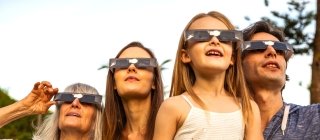How to View the Eclipse Safely

To safely enjoy the rare total solar eclipse visible in Vermont on April 8, it's crucial to protect your eyes with certified eyewear, understand proper usage, and avoid hiking in mountainous areas during the event.
One of nature’s grandest spectacles will make a rare appearance in our state on April 8, when a total solar eclipse is visible in northern Vermont. Thousands of Vermonters and visitors will look skyward to witness the moon completely blocking the sun’s light. As wonderous as this is, it can also be hazardous to your eye health. It’s important to take proper precautions to stay safe and prevent permanent damage to your eyesight.
Eclipse Viewing Risks
Humans know instinctively when the sun is too bright to look at directly. That innate sense of danger protects us most of the time, explains Mark Breen, senior meteorologist and planetarium director at the Fairbanks Museum and Planetarium in St. Johnsbury. However, eclipses are so rare that our eyes don’t know how to react and we lose that natural protection, he says.
Even though the sun is diminished during an eclipse, the hazard remains. “When the moon begins to cover up the sun, particularly when a crescent of the sun is still visible, that crescent is as bright and as intense as any point on the sun,” Breen says. The very intense light will harm photoreceptor cells in the eye’s retina, which sense light and send signals to the brain. “Very often, this results in permanent damage. It’s not reversible,” he says.
How to Protect Your Eyes
With the risk of eye damage so great, you’ll need to take steps to protect your eyes if you want to view the eclipse. “It is absolutely crucial that people either wear protective eyewear or there are a few other safe ways to view it,” says Breen.
Special glasses and filters are available which block the harmful effects but still allow users to see the eclipse. Most public schools in the path of totality will have glasses available to students, while many public libraries and town offices have glasses for the general public. Check with your local library or town clerk's office to see when they’re available. Inexpensive “eclipse glasses” are available from online retailers, but you should only buy ones that have been certified to meet the international safety standard ISO 12312-2. The American Astronomical Society (AAS) has compiled a list of suppliers and authorized dealers on its website.
Vermonters can also check with their eyecare professional or local government to see if they have eclipse glasses available, Breen says. The Fairbanks Museum has a limited number for sale, he adds.
Once you have the right eye protection, you also need to know how to use it correctly. It’s important to not take the glasses off too early as the eclipse progresses. “As long as you are still seeing any part of the sun through your eclipse glasses — even a thin edge — you need to leave them on,” Breen says.
For a few minutes, people viewing from within the “path of totality” in northern Vermont will be able to remove their eclipse glasses. “Just as the last bit of sun is about to disappear, you can’t see it in the eclipse glasses anymore. At that point, when it is fully eclipsed, it’s safe to take them off,” Breen says. “You’ll at that point see a glow of light around the sun, known as its corona, and during that totality it is safe to view without the eclipse glasses. In fact, you won’t see anything if you leave them on.”
Likewise, it’s important to know when to resume using eye protection. “As soon as you start seeing that thin sliver of sun reappear, you need to put the eclipse glasses back on,” Breen says.
Vermonters viewing the eclipse in southern parts of the state will need to always use protective gear. Middlebury, Barre, and St. Johnsbury are on the southern edge of the path of totality. Locations south of those communities will only see a partial eclipse, so if you’re watching from there, you’ll need to keep your eclipse glasses on the entire time.
If you don’t have eclipse glasses, you’re not out of luck. You can still view the eclipse safely using indirect methods, such as pinhole and optical projection. Check out the AAS website for instructions.
Where to Watch
Along with the right eye protection, you should also choose a safe location to watch the eclipse. One place you shouldn’t go is up into Vermont’s mountains.
The Green Mountain Club (GMC) is concerned that eclipse watchers will seek a high vantage point on Vermont’s mountain tops. The GMC is urging eclipse viewers to avoid the state’s backcountry and instead watch from cities and towns.
The eclipse will occur during Vermont’s mud season when high-elevation trails are susceptible to damage from foot traffic, notes Chloe Miller, the GMC’s communications manager. “Hiking directly through the mud, the mud is wet and squishy, so those footsteps compact the soil and that can exacerbate trail erosion,” she says.
It can still be very wintery in the mountains in early April, Miller says, and eclipse watchers may not be prepared for those conditions. With tens of thousands of visitors flocking to the state to view the eclipse, public safety agencies will be stretched thin and there won’t be the normal emergency support for hikers, she adds. “We’re concerned about people’s personal safety if they are not used to hiking in Vermont’s mountains.”
If you prefer to watch the eclipse in a natural setting, some Vermont state parks will be open, although services will be limited. Many northern Vermont communities will hold events the day of the eclipse and during the weekend leading up to it. Check out Vermont Public’s list of eclipse events around the state.
The Fairbanks Museum and Planetarium will hold a family-friendly event from 12 p.m. to 5 p.m. on April 8. There will be activities for kids, including building an eclipse box that uses a pinhole to project an image of the crescent sun. Telescopes with special filters will be set up so you can see the eclipse in more detail. If you can’t make it to St. Johnsbury, or you’re not able to see the total eclipse from your location, Breen will cohost a live broadcast on Vermont Public from 3:00 to 4:00 p.m.



